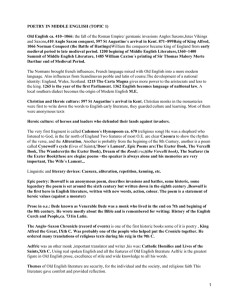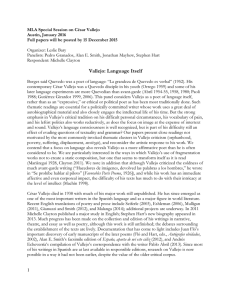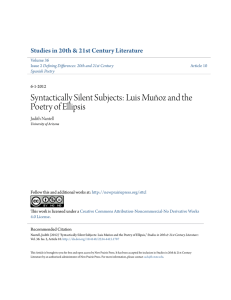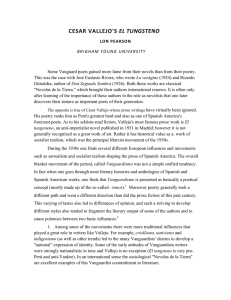The Paradox of Vanguardismo
Anuncio
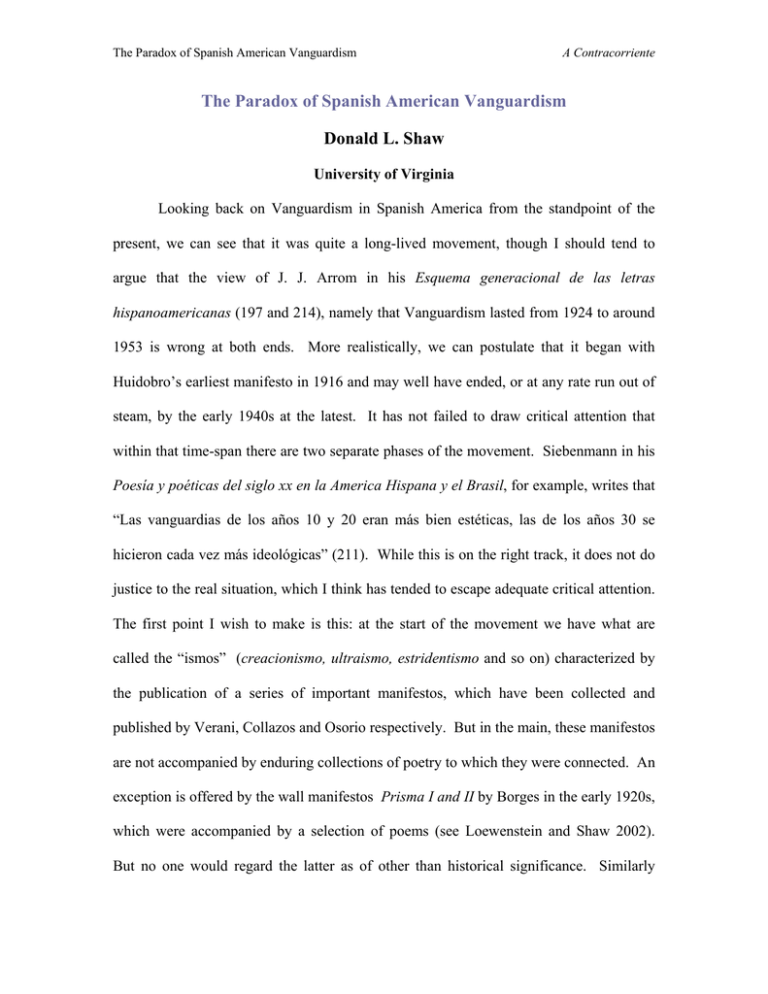
The Paradox of Spanish American Vanguardism A Contracorriente The Paradox of Spanish American Vanguardism Donald L. Shaw University of Virginia Looking back on Vanguardism in Spanish America from the standpoint of the present, we can see that it was quite a long-lived movement, though I should tend to argue that the view of J. J. Arrom in his Esquema generacional de las letras hispanoamericanas (197 and 214), namely that Vanguardism lasted from 1924 to around 1953 is wrong at both ends. More realistically, we can postulate that it began with Huidobro’s earliest manifesto in 1916 and may well have ended, or at any rate run out of steam, by the early 1940s at the latest. It has not failed to draw critical attention that within that time-span there are two separate phases of the movement. Siebenmann in his Poesía y poéticas del siglo xx en la America Hispana y el Brasil, for example, writes that “Las vanguardias de los años 10 y 20 eran más bien estéticas, las de los años 30 se hicieron cada vez más ideológicas” (211). While this is on the right track, it does not do justice to the real situation, which I think has tended to escape adequate critical attention. The first point I wish to make is this: at the start of the movement we have what are called the “ismos” (creacionismo, ultraismo, estridentismo and so on) characterized by the publication of a series of important manifestos, which have been collected and published by Verani, Collazos and Osorio respectively. But in the main, these manifestos are not accompanied by enduring collections of poetry to which they were connected. An exception is offered by the wall manifestos Prisma I and II by Borges in the early 1920s, which were accompanied by a selection of poems (see Loewenstein and Shaw 2002). But no one would regard the latter as of other than historical significance. Similarly The Paradox of Spanish American Vanguardism A Contracorriente Huidobro’s early creacionista verse, though more important, is rather overshadowed by Altazor, which did not appear until 1931. The suggestion is that the mature masterpieces of Vanguardism in Spanish America were Trilce (1922) by Vallejo, by far the earliest, followed, as we have just seen, by Huidobro’s Altazor in 1931 and by Neruda’s Residencias in 1935. Not everyone, of course, agrees that these three works constitute the canon of mature Vanguardism, and I appreciate some of the relevant arguments. But if we detach these works from Vanguardism, we are left with the conclusion that the movement only produced relatively second-rank works like Neruda’s El hondero entusiasta, written around 1923 or Paz’s Luna silvestre (1933). Now, wherein lies the paradox? I suggest that it lies in this: as we read the manifestos, for example in Hugo Verani’s collection, we recognize a tone of youthful optimism, of vitalism, a sense of liberation, even a certain euphoria. In Puerto Rico there was even a manifesto euforista. This up-beat tone is directly connected with the idea, also characteristic of many of the manifestos, that the new poetry would and should reflect the modern spirit or what Jorge Mañach in “Vanguardismo” called at the time “la fisonomía peculiar del tiempo que vivimos” (Verani 133). But one of the most striking features of these early manifestos is the complete absence of any significant attempt to define, much less analyze, the “modern spirit” which Vanguardist poetry was supposed to express. It seems to have been ingenuously taken for granted that (as for example Marinetti and the Futurists in Italy had proclaimed) that modernity and especially modern technology was in itself intrinsically and automatically exciting, positive, vital and appealing to the young. What we can now see is that the “espíritu de la época,” in the aftermath of the First World War, was neither 32 The Paradox of Spanish American Vanguardism A Contracorriente constructive nor affirmative. What the writers of many of the early manifestos failed to realize in their enthusiasm to see a renovation of poetry was that the West had entered a phase of cultural crisis, intensified by the unprecedented destruction and carnage of the First World War. This left a deep scar on Western sensibility comparable to that left by the dropping of the atomic bomb on Hiroshima. And so it is not surprising that, when we turn from the manifestos to the mature poetic works we find, for example, Huidobro’s Altazor described as an “animal metafísico cargado de congojas” (Obras completas I 393), we find Vallejo lamenting the human condition and Neruda declaring in “Walking around” in the second Residencia en la tierra that he was tired of belonging to humanity. While this paradox has not been entirely overlooked by criticism (Yurkievich in particular has alluded to it indirectly [1982: 353]), it has not been adequately developed. And this brings me to my second and third points. The second point is that many of the manifestos (those of Borges are a case in point, and in Nicaragua José Coronel Urtecho went the length of actually writing a poetic attack on Darío which Verani (157-159) includes as a fully fledged Vanguardist manifesto) go out of their way to denigrate modernismo, the last gasps of which are seen as creating an obstacle to the renovation of poetry in the new generation. But by failing to see that, as modern criticism has amply shown, modernismo was characterised by “poesía de temple agónico y existencial” which “prefigura espiritualmente la modernidad” (Olivio Jiménez 11 and 22) the writers of the Vanguardist manifestos also failed to realize the strong links between the sensibility of modernismo and that of the mature Vanguardists. This is one of the great failings of Paz criticism in particular to the present day. The third point is that the figure that courageously attempted to prick the bubble of early Vanguardist euphoria was César 33 The Paradox of Spanish American Vanguardism A Contracorriente Vallejo. In three characteristically far-sighted articles published between 1926 and 1930, and collected by Verani: “Poesía nueva” (190-191), “Contra el secreto profesional” (192194) and “Autopsia del surrealismo” (195-199), he returned to the question of the relationship between the new poetry and the new outlook on life in order to assert categorically that in the period of the “ismos” the link between the two had been lost. Let us briefly remind ourselves of what Vallejo had to say, keeping in mind that he was already a published poet and that his views are to some extent self-serving and referential to his own poetry. In “Poesía nueva” in 1926 he takes issue with the notion that the new diction of Vanguardism, influenced by the Italian Futurists, with its up-to-the minute references to the cinema, radio, cars, airplanes and other aspects of modern technology automatically expressed a new sensibility. Secondly, he criticizes the view put about by Huidobro that “metáforas nuevas” (190), which are implicitly independent of any direct relationship with experiential reality, represent a major step forward towards a “new” poetry. Instead, he argues, poetry has to be anchored in lived experience and in consequence will always be “simple y humana” (191). The shortcoming of the article is that Vallejo, while clearly recognizing that a new sensibility has emerged to be expressed, does not explain what it is like, beyond making a vague reference to “las nuevas relaciones y ritmos de las cosas” (190), which does not take us very far. Almost a year later, in “Contra el secreto profesional” his attack is more specific. It is directed against Neruda, Borges and the Mexican estridentista Maples Arce (as well as Chocano!). We can also recognize a certain hostility to Huidobro, though he is not named. This time Vallejo asserts roundly that a whole set of characteristics, which he enumerates and which are clearly those of Vanguardism, is simply imitative of French 34 The Paradox of Spanish American Vanguardism A Contracorriente poetry. Once more he fails to define what kind of “nuevos asuntos” (193), what new sensibility, is expressed, and contents himself with calling for “un latido vital y sincero”, and “emoción seca, natural, pura, prepotente y eterna” (194). But he insists, there is not a single poet of his generation (presumably except himself) whose work reveals it. It is in the last article “Autopsia del superrealismo” of 1930 that he finally refers to “una nueva decadencia del espíritu” (195) and to “pesimismo y desesperación” (196) as characteristics of Surrealism and thereby of the mainstream poetry of his time. But by now he argues that the contemporary “crisis morales e intelectuales” (197) are the result of collapsing capitalism and that the revolutionary spirit of marxism is the answer. I am not, of course, suggesting that these articles by Vallejo are not well-known, at least to specialists. What I am saying is that I have not found in the criticism that even specialists have related them to the kindred articles by Neruda, Paz and Nicanor Parra all of which argue that the really new poetry (which they are actually writing, as distinct from advocating) should be quite different from the kind of poetry called for by the Vanguardist manifestos. Neruda’s famous “Sobre una poesía sin pureza” (Obras completas III 636-637) of 1935, as we all know, from the title on, dismisses the sort of “pure” poetry that the “ultraístas” and “creacionistas” believed in. What is perhaps less often noticed is the reference at the beginning of the piece to “el torturado poeta lírico” (636), not at all the euphoric, modernity-loving figure of the manifestos. To make matters more explicit, Neruda includes “negaciones,” “dudas” and “la entrada en la profundidad de las cosas” (637) as among the themes of “impure poetry”. Two years later in 1937, during a trip to Spain in the middle of the Spanish Civil War, Octavio Paz delivered a lecture,entitled “Noticia de la poesía mexicana contemporánea”, collected in 35 The Paradox of Spanish American Vanguardism A Contracorriente Professor Santí’s invaluable Primeras letras (134-137), in which he echoed deliberately the repeated assertion of the manifestos that the new poetry must deal with “el drama del hombre de hoy” (137). But how are we to envisage that drama? Paz is even more explicit than Neruda in the article just mentioned, but not more explicit than either Neruda or Vallejo had been in their poetry (i.e. the Residencias and Trilce). He refers openly to “la crisis metafísica” (135) of the times that has produced the vision of “un hombre desdichada y cruelmente fragmentado, roto” (136). Like Vallejo, he asserts that the contemporary Vanguardists in Mexico (he mentions Gorostiza, Villaurrutia and Novo), “olvidaron al hombre, preocupados como estaban por la mera perfección” (136) that is, by formal “purity”. Interestingly he uses the same term as Vallejo, calling for a poetry that will “plantear poéticamente, es decir humanamente” (136) the contemporary human drama. Similarly at this time (but not of course later) he asserts that this new poesía humana will express “la lucha del proletariato” (137). What is surely interesting about all this is that these three practitioners, that is to say poets, as distinct from writers of manifestos, who often were not significant practitioners, all in one way or another criticize the assumptions governing early Vanguardism about the subject matter, the tone and the diction which were in vogue during the early and middle 1920s. All of them contradict the tone of euphoria, the uncritical worship of the modern and along with them the dehumanization of so-called “pure” poetry which we associate with early Vanguardism. And yet Vallejo and Neruda are regarded as having produced two of the masterworks of the movement. This was not the way I was taught to look at Vanguardism. But it does not end there. For the critical question now arises: how does this paradoxical situation affect the next generation of 36 The Paradox of Spanish American Vanguardism A Contracorriente Spanish American poets? One aspect of the answer is provided by the publication of Neruda’s “Alturas de Macchu Picchu” in 1945, followed by Canto general into which it was incorporated, in 1950. If we compare the opening of “Alturas” with the final cantos of the poem we can see quite clearly how the medium reflects the message. The opening, which deals primarily with the soul of man under capitalism, the death-in-life of the urbanized masses, alienated from authentic life and unaware even of the spiritual sterility inflicted on them, is written in the same hermetic style as the poems of the Residencias. But the last cantos of the poem, which call for a new Macchu Picchu as the symbol of a new Socialist society constructed in liberty, are in the much more “human,” straightforward, communicative style of Canto general and the Odas elementales. The shift illustrates exactly what Vallejo in 1930 and Paz in 1937 thought was wrong with Vanguardism. But a different kind of shift had already begun to take place. In 1958 Nicanor Parra gave a little talk, afterwards published in Atenea (nos. 380-381) about the publication, twenty years earlier, that is, in 1938, of an anthology of poetry by young Chilean poets active in the late 1930s. The title of the talk was, significantly “Poetas de la claridad”. In it, he speaks of the “significado polémico de los postulados que ella [the anthology] planteaba tácitamente” (46). A mere five years after the famous anthology of Anguita and Teitelboim which had given the accolade to the Vanguard in Chile, Parra affirms, he and his group began a reaction along the same lines of clarity and naturalness which Vallejo had advocated (but not practiced) eight years earlier and which Neruda was to accept in the middle 1940s. In the midst of vanguardism, this group of young Chilean poets rejected the vanguardist position. “A cinco años de la antología de los poetas creacionistas, versolibristas, herméticos, oníricos, sacerdotales”, he declared, 37 The Paradox of Spanish American Vanguardism A Contracorriente referring obviously to Huidobro, Neruda and others, “representábamos un tipo de poetas espontáneos, naturales…paladines de la claridad y la naturalidad de los medios expresivos” (47). Not surprisingly, when we look at what Parra wanted to say, using this new pattern of diction, we find that, just as the mature Vanguardists rejected the ornamental imagery of the modernistas, but inherited their sense of existential crisis, so Parra rejected the hermetic diction of the Vanguard, but took over in turn the metaphysical disquiet, the congoja of the movement. “El poeta”, he was to say later, “anda buscando la casa para el hombre actual, que está a la intemperie” (Morales 104). In conclusion, then, we can repeat that in the main the authors of the Vanguardist manifestos chiefly in the 1920s advocated hostility to modernismo combined with an upbeat attitude to the modernity the poetry was supposed to express and a more or less dehumanized “pure” pattern of diction stripped of anecdote and relationship to lived experience. But the mature vanguardists, who were practictioners, while accepting the renovation of diction and the rejection of modernismo, rejected the yea-saying of the twenties and called increasingly for an “impure”, humanized poetry, which expressed awareness of the post World War I crisis of modernity. This led in the end away from Vanguardist diction to greater communication, naturalness and clarity, but also to the inheritance by the next generation of poets, led by Parra among others, of a sense of man’s existential orphanhood. 38 The Paradox of Spanish American Vanguardism A Contracorriente WORKS CITED Arrom, José Juan. Esquema generacional de las letras hispanoamericanas. Bogotá: Instituo Caro y Cuervo, 1963. Collazos, Oscar. Los vanguardismos en la América Latina. Barcelona: Ediciones Península, 1977. Huidobro, Vicente. “Altazor” in Obras completas I. Santiago de Chile: Andrés Bello, 1976. Jiménez, José Olivio. Antología crítica de la poesía modernista hispanoamericana. Madrid: Ediciones Hiperión, 1985. Loewenstein, C. Jared and Shaw, Donald L. “Prisma I and II”, Hispanic Review, 70 (2002): 69-88. Morales, Leonidas. Conversaciones con Nicanor Parra. Santiago de Chile: Universitaria, 1991. Neruda, Pablo. “Sobre una poesía sin pureza” in Obras completas III (Buenos Aires, Losada, 4th ed., 1973): 636-637. Osorio, Nelson. Manifestos, proclamas y polémicas de la vanguardia literaria Hispanoamericana. Caracas: Ayacucho, 1998. Parra, Nicanor, “Poetas de la claridad”, Atenea, 380-381 (1958): 45-48. Paz, Octavio. Primeras letras 1931-1943. Ed. Enrico Mario Santí, Mexico: Vuelta, 1988. Siebenmann, Gustav. Poesía y poeticas del siglo xx en la América hispana y el Brasil: historia, movimientos, poetas. Madrid: Gredos, 1997. Verani, Hugo. Las vanguardias literarias en Hispanoamérica: manifestos, proclamas y otros escritos. Mexico: Fondo de Cultura Económica, 1990. Yurkievich, Saúl. “Los avatares del vanguardismo”, Revista Iberoamericana, 118-119 (1982): 351-366. 39
